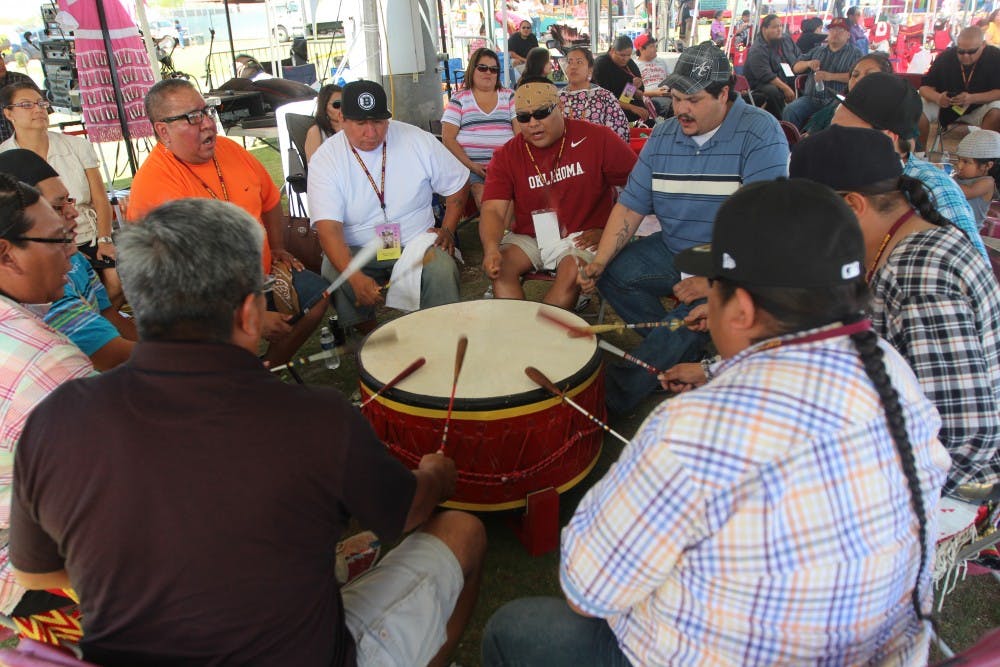 A Native American dancer wears traditional feathers at ASU’s powwow event on the Tempe Campus. ASU had one of the nation's largest indigenous graduating classes in 2013. (Photo by Dominic Valente)
A Native American dancer wears traditional feathers at ASU’s powwow event on the Tempe Campus. ASU had one of the nation's largest indigenous graduating classes in 2013. (Photo by Dominic Valente)Almost 300 students from more than 65 tribes walked at ASU's Indian American convocation ceremony in May, making ASU one of the nation's largest indigenous graduating classes in 2013.
John W. Tippeconnic, a member of the Comanche and Cherokee tribes and a professor in the American Indian studies program, said ASU is recognized as a leading institution for American Indian students, both statewide and nationwide.
"When you look at the entire list of students that have graduated from ASU from different tribes, the University is definitely growing in recognition," he said. "ASU has more than 2,000 American Indian students, and that number is growing, making ASU a major player in American Indian higher education."
Tippeconnic said these numbers are significant, because they are helping facilitate American Indian communities to recognize and value the importance of higher education.
He said American Indians face the same challenges as most Americans when seeking higher education, including finding the resources to attend a major university, especially with the price of higher education rising.
 Ritual drummers at ASU’s powwow event beat rhythmically as members of various tribes dance to the beat. At ASU, members from over 60 different tribes attend classes. (Photo By Dominic Valente)
Ritual drummers at ASU’s powwow event beat rhythmically as members of various tribes dance to the beat. At ASU, members from over 60 different tribes attend classes. (Photo By Dominic Valente)However, American Indian students also face additional challenges finding adequate education at the K-12 levels, even though it is improving, Tippeconac said.
"Some of the high schools on Indian reservations are not the best schools," he said. "They are not high performing and don't usually offer AP classes. It is getting better but the quality of education before coming to ASU is a concern."
Tippeconnic said the other main challenge many American Indian students face is a language and culture barrier.
"Students that are actively engaged in who they are as Indian people, can face conflicts in terms of education and terms of education and schedules," he said. "There is a real strong tie to family and extended family and often times students are called back to help play a role in their family. So that can also have an effect in terms of their academic work here on campus."
Lei-Lani White, a Navajo who graduated from ASU with a doctoral degree in nursing, said ASU has done a great job recruiting American Indian undergraduates and provides many grants and financial opportunities for American Indians to succeed.
White, a mentor in the American Indian Students United for Nursing, said one of her biggest struggles was learning to write papers and learning how to express herself in a scholarly manner.
"A lot of people don't have confidence and don't believe in themselves," she said, "mainly because of the language barrier."
White said another struggle faced by many American Indians is the ability to pay for college. She said she had to support herself 100 percent throughout her journey to getting her Ph.D.
"I think that financing college is a really big struggle for so many American Indians," she said. "ASU does a good job at helping students manage this issue."
White said she utilized the American Indian support services, especially the group dedicated to nursing students, in many ways, including using the free computers and printing services and helping pay for her education by receiving a scholarship.
"It's important for us to pursue higher education and get degrees so that we can become leaders in fields like healthcare," she said. "By graduating with degrees, we can make changes in our communities, improve lives and be great role models for future generations of Indian American students."
Michael Begaye, the executive director of the American Indian Student Support Services, said the University makes a concerted effort to reach out to American Indians in high schools, community colleges and on the reservation.
"There are some really key things that happen in recruiting students," he said. "We try to make an early connection and our program tries to reach out to the American Indian freshman to make that transition from home to the University as easy as possible."
Begaye said the AISSS employs a program that tries to help students understand how to be successful in their transition, as many come from very lifestyles different from those they find at ASU.
He said many American Indian students struggle with leaving their families, because they feel responsible for their financial situations and want to help as much as possible at home.
"The family obligations that they feel at home can impact how well they do at school," Begaye said.
Once American Indian students become sophomores or juniors, AISSS tracks students' GPAs and financial statuses and connects them to outside professionals in their fields and in the community, Begaye said.
"I don't know if any other program in the country advises their American Indian students like that," he said.
Reach the reporter at npmendo@asu.edu or follow him on Twitter @NPMendoza




